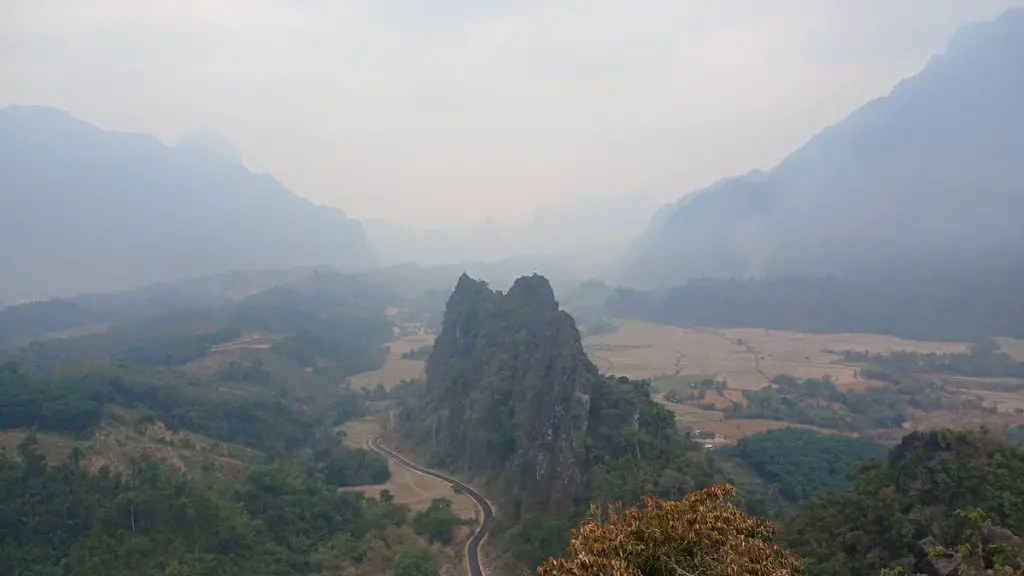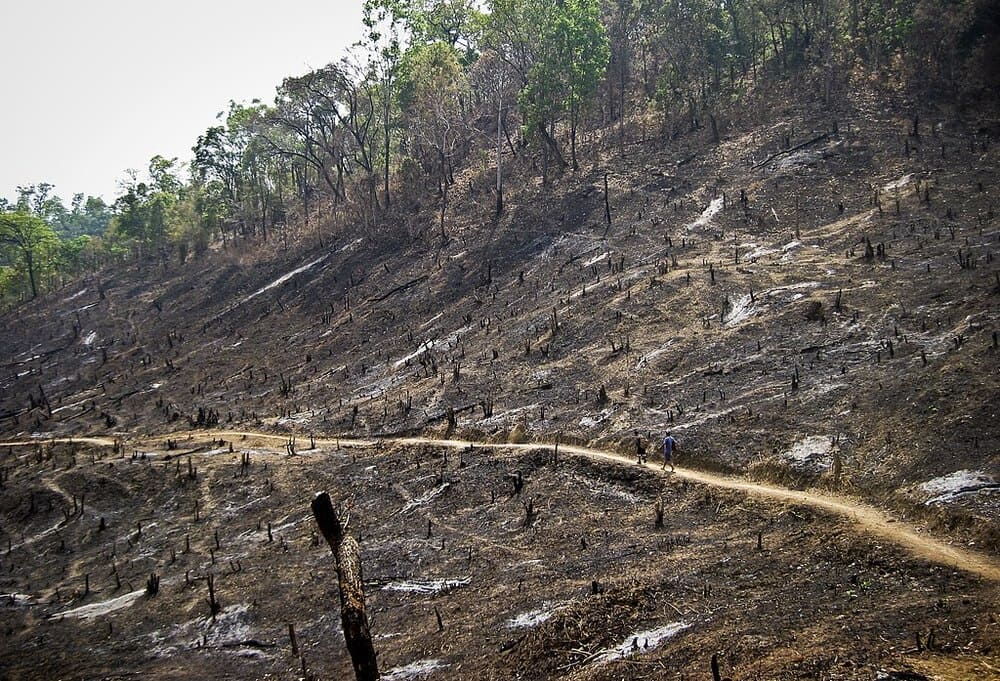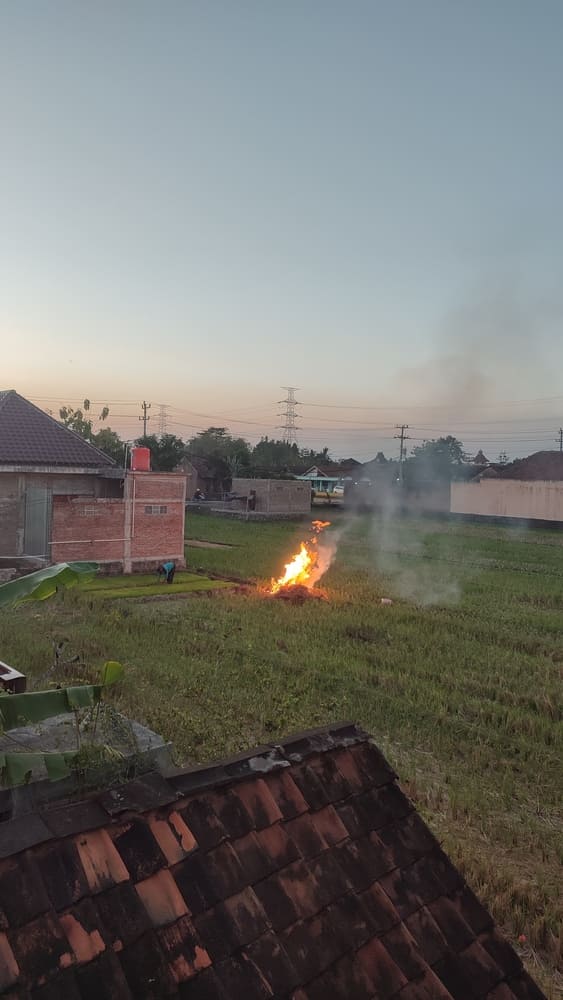Burning Season in Laos – Is it Really That Bad?
The Burning Season in Northern Laos and Northern Thailand is a floating period between February and May when local farmers burn their agricultural fields in preparation for the new planting season.
Burning is widespread and creates a layer of smog and haze over the regions. The air quality drops significantly, often to dangerous levels.
I traveled to Laos in the first half of March and most of my pictures look blurry and hazy due to the smoke. Yes. the burning season in Laos is very uncomfortable.
It was worse in North Laos than in the South but almost all of the country experiences a burning season to some extent.
It’s not impossible to travel but if you are flexible and can easily reschedule your trip to before March or after April – do so.
When is the Burning Season in Laos?

Technically speaking, the burning season (anywhere it’s practiced, not just in Laos) happens at the end of the dry season and right before the start of the wet season.
Historically, it started at the end of March and continued only until the end of April.
Enter global warming.
With weather changing rapidly all around the globe, Laos included, the wet season has become more unpredictable. Farmers need to burn the crops before the rain comes (more on why later) so they start burning earlier so as not to miss the best time.
Today, the burning season in Laos starts as early as January and ends as late as June!
It’s still most serious in March and April though.
Songkran (also known as the Lao New Year or more colloquially the Water Festival) unofficially marks the end of the burning season sometime in late April.
It usually precedes the coming of the monsoon rains that will clear the air. However, as mentioned already, global warming has made it a bit more unpredictable.
Which regions of Laos are affected by the burning season?
The burning season affects all regions of Laos but to a different extent.
Northern Laos, including Vang Vieng, Luang Prabang, Phongsavan, Nong Khiaw, Huay Xai, and Luang Namtha sees a lot more burning than the south. The sky is hazy, visibility is low and fire is a lot more widespread.
Whether due to the lower population density or the smaller size of arable land, the burning season in Southern Laos is not as bad as in the north. Cities like Savannakhet, Thakhek, and Pakse are also hazy and smoky in March and April but the situation is better than in the south.
I found the air quality quite good on the Thakhek Loop but somewhat bad on the Bolaven Plateau Loop (starting in Pakse) where the dusty road conditions also bring a lot of particles in the air.
Traveling in Laos during the burning season
I was in Laos in the first half of March. When I arrived in Luang Prabang in the first days of March, I could already tell that it was the burning season.
The air was hazy and smoky. It smelled like something was burning everywhere. My pictures were all brownish and blurry.

Then I traveled north of Luang Prabang, through Nong Khiaw and Luang Namtha to reach Huay Xai to take the slow boat down the Mekong and get back to Luang Prabang.
While I was on the boat I realized just how bad air quality was. It was difficult to breathe. My clothes absorbed the smell and at the end of the day when I smelled them it was as if I had put my nose inside an exhaust pipe.

The Mekong River was supposed to be pretty and picturesque with lots of opportunities for photos of the surrounding mountains. During the smokey season in Laos, this is just not the case.
You cannot see further than a few hundred meters, breathing is difficult and it’s surely hazardous to health.
When I returned to Luang Prabang 10 days later, it was even worse than the first time.

South, in Vang Vieng, it was a similar experience – haze, smoke, and a burning smell. The magnificent karst mountains were obscured in a cloud of smog. The view from the Nam Xay Viewpoint was as if shrouded in a gray veil of smog.
All the way south to the capital Vientiane you could still feel the smoke. I have to say it was a little better there. Since I’m comparing it to the gas chamber that Luang Prabang felt like, this is not a big accomplishment.
In South Laos, the situation was better but still palpable. Thailand on the other side of the Mekong from Thakhek was slightly veiled in gray smoke.
Further south still, the Lao-Nippon Bridge in Pakse was enveloped in haze too.

All in all – yeah, you can travel to Laos during the burning season. I did it. It is possible. There were also many other backpackers.
But was it pleasant? Not as much as one would hope. Was it hazy, smoky, and smelly? Yes. Was it bad for my health? Most certainly.
If possible, travel to Laos outside of the burning season. And if you have asthma or other breathing problems – forget it.
Can you protect yourself from the smoke with a mask?
You can add some level of protection against the smoke by using a mask.
First things first, forget about the basic surgical masks. They protect against air droplets and are not fine enough to block the tiny dust and ash particles from burning.
When it comes to air pollution, particulate matter is as small as 2.5 micrometers. This is too small to be seen by the naked eye and small enough to enter the lungs and even the bloodstream.

The high-grade, high-quality masks that became world-known during the pandemic offer some protection against these small particles.
Masks such as N95, FFP2, and KN95 offer up to 95% filtration of particles as small as 0.3 microns. These are your best bet for protection during the burning season in Laos.
Why is there a burning season anyway?
Humanity has practiced agriculture for at least 12.000 years. Over this period, we, collectively as a species, have perfected it to produce more and more food. It would not be possible to have a world population of over 8 billion without these advances.
One strategy to increase agricultural output is the so-called slash-and-burn technique.
It has been practiced in many places around the world throughout the ages, although nowadays it’s mostly still done in South and Southeast Asia.

In slash-and-burn, farmers cut down everything in the targeted area and leave it to dry during the dry season. Right before the rainy season, they burn it, creating a layer of extremely fertile ash and killing all weeds and pests in the process.
The drawback to this method is that it depletes the land quickly. Every 5 years or so, farmers would abandon the land and move to other places. You can see how this method requires flexible ownership of the land and would not make sense for farming on the same land for decades.
To summarize, there is a burning season, because burning is an extremely effective (albeit only short-term) method for increasing the productivity of agricultural land.
Burning season in other countries
The burning season is not only a Lao thing. Neighboring Southeast Asian countries also have their own burning seasons.
Thailand
It gets much worse in neighboring Thailand, where the northern parts experience some seriously dangerous levels of air pollution.
In 2023, Chiang Mai became the world’s most polluted city for a few days. The air quality index hit 223, a number 15 times higher than the recommended maximum. Not a year goes by without Chiang Mai hitting the news again with dangerous levels of air pollution.
Cities like Chiang Rai, Pai, Chiang Dao, Mae Hong Son, Phayao, and Nan also experience severe air pollution during the burning season in Thailand.
Indonesia, Malaysia, and Singapore
Due to differences in climate and seasons, the burning season in Indonesia (mostly in Sumatra and Kalimantan/Borneo) and in Malaysia (both Peninsular and Borneo) occur between August and October.
It is just before the onset of the rainy season. Read about Indonesia’s rainy season or specifically about Bali’s rainy season.
It’s caused by much the same culprits – the burning of agricultural fields and forest fires.

Squished between then, Singapore doesn’t have agriculture going for it but still suffers from the burning season. There isn’t much that can be done to stop the haze from traveling all around the region.
Nonetheless, the burning season in Malaysia, Indonesia, and Singapore doesn’t get as bad as in Northern Laos and Northern Thailand if I say so myself.
Vietnam
Vietnam also experiences burning season but to a lesser extent than its neighbors in Laos.
People in Central Vietnam practice slash-and-burn agriculture and you may experience some poor air quality in these regions between May and July.

In the northern parts of the country, the rainy season starts somewhere in May and so the burning season is between February and April (flexible as anywhere else).
I was in North Vietnam at the end of February (both Sapa and Ha Giang) and the air quality was quite good. Turns out it’s much less likely to experience smoke and haze in Vietnam than in Laos.
